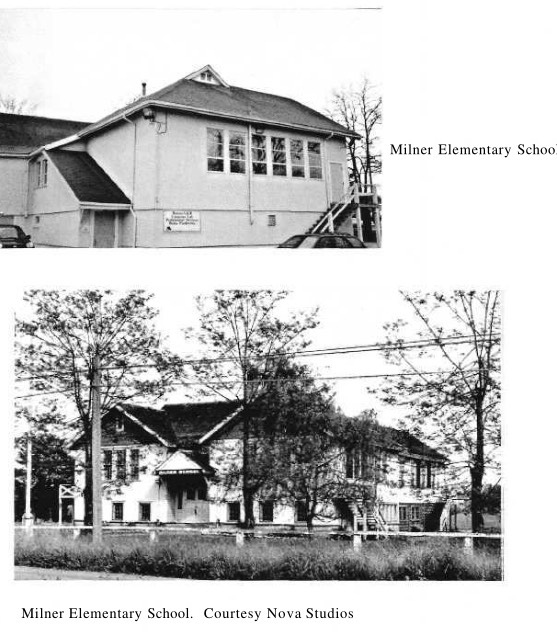In 1910, the junction of Langley Trunk Road and Townline Roads (Glover/216) was named Milner Station, when the BC Electric Interurban was constructed through the area. It was named after Lord Alfred Milner, an English notable whose life William John Mufford had been reading about. He suggested the name, and it was chosen over the name, Berry’s Station, in a hard-fought vote among the citizens of the day. Located in the centre of the former Hudson’s Bay Farm, Milner had a general store, the Bank of Hamilton, a church, a few houses, and Moir’s Blacksmith Shop.
Since the Langley Prairie School on Townline Road was closer to Milner than to Langley Prairie, the school board renamed the school Milner School. The school was moved north to Milner and set up on the east side of Townline Road, next to Moir’s Blacksmith Shop. Here it served for a couple of years until a new Milner School was opened in 1913.
Miss Jennie Estey was the first teacher at the Milner School, and later (as Mrs. Jennie Medd) taught at Langley High School. One day, the bigger boys in her class (grades 1-8) decided to get a holiday for themselves. They filled the chimney with bricks or stones, thus producing a very smoky fire. Miss Estey delegated the big boys to clean out the stove and pipes, and sent the smaller children home. So much for their planned holiday!
In 1914, a new plastered school with two rooms, large windows, and a basement was built by Mr. Owen Hughes on Glover Road on land purchased from J. H. Mufford. A third room was added later. In 1957 the building was renovated with lowered ceilings, new windows, tiled floors, and tables and chairs in place of the well-scarred desks of the early days. Further renovations were made in 1968, with the completion of a modern building behind the original two-storey building on Glover.
Several well-known teachers in Langley taught at Milner: Mrs. G. Rawlison, Mrs. J. Jamieson, Mrs. B. Finlayson, Miss Alice Brown, Miss Olsen, Mr. P. Staniworth, and Mr. R. Mountain (who also went to school in Milner and became principal of Langley High School).
In 1922, Langley High School moved from Murrayville to Milner School where it remained until Langley High School on Yale Road was constructed in 1924.
The Hutchison family, who lived on Medd Road (64), brought along a hammer to school each day to knock down the field fence off 216 until the School Board made the present lane which leads to the school from Johnson-Townline (216).
One time some pupils persuaded one of the young cows fresh out to spring pasture to enter the school and climb the stairs to the main hallway. Pupils thought it was hilarious, but the teachers were not amused when the cow dumped all over the floor. The cow had to be rolled down the stairs to get her out.
When there was no longer a need for a school in the Milner area, the buildings became the Milner Education Centre, which included rooms for audio-visual, a boardroom for the School Board, a main office, media production and instruction services, a science room, computer lab, and two meeting rooms. Many teachers worked at Milner over the years, providing professional development courses and services to all the schools of Langley. In 2001, many of these services were transferred to the School Board building’s third floor. In 2004 the Milner Education Centre is being offered for sale.
The End of an Era!
by Annette O’Connor
Milner Education Center will be closing its doors for good on December 17th. Here are some interesting anecdotes from the book “Legend of Langley” that was published in 1958, as well as recollections from Jean Gregson, whose father Bill Blair attended Milner in 1919.
About 1914, a fine new plastered school, with two rooms, large windows, and basements, was built by Mr. Owen Hughes on Glover road, on land purchased from J. H. Mufford. A procession of pupils left the small dingy “little red schoolhouse” behind and took possession of their fine new building, which has served the community of Milner ever since.
The school was called Milner after the small community of Milner, which was a thriving little community in the early 1900s. Milner was named after Viscount Milner, a British colonial administrator and was a station on the BC Electric Railway Co. Interurban line.
Long-time residents remember the planting of the trees and lawn, which now give the school one of the most attractive grounds in the district. They recall that at one time the children had individual garden plots at the back of the yard, and that one year the pupils danced in the basements to the music of comb and tissue paper.
And the story of the cow that came to school still is told with laughter. It seems some of the pupils persuaded one of the young cows fresh out to spring pasture to enter the halls of learning and climb the stairs to the main hallway. Pupils were hilarious, the teacher irate, and the cow-well, spring grass and mortal terror were too much for her! She had to be rolled down the stairs to get her out; fortunately, without broken bones, but the school wasn’t the same for days!
The Milner staff encourages you to visit them at their new sites. The professional development staff and services will be moving to the 3rd floor of the School Board office. Three meeting rooms will be available. The audio-visual staff and services will be moving to Langley Secondary.
Milner School, by Jennie Medd (nee Estey)
(quoted from “Growing Up in the Valley,” pages 62-3)
I applied for a school at Milner and got it in November, 1912. It was a one-room school, and I believe it had been rather unruly. One day the chairman of the School Board called on me, and he told me that one of the teachers had become so annoyed, she had taken the slate and smashed it over the youngster’s head, then told him to go home with the frame around his neck. He rather admired her for her spirit. But some of the parents didn’t like it quite so well. They told me that the lady that had gone just before I arrived was a large woman and a fairly good disciplinarian, but she simply couldn’t stand those youngsters, and had refused to stay any longer. When I arrived, they gave me until Christmas to be finished off. But I thought, well, I’m not going to be driven out by a little group of youngsters, no matter how unruly they seem to be. However, after a time I succeeded. I gave one boy a jolly good strapping~I took one of the big ones—and that settled them all.
It was rather a large school of 44 children. They had all the grades from grade one to the entrance class, and at that time they were writing the government examinations, which meant a great deal of work for the senior class. They had thirteen written examinations to take and they had to pass their exams with a good standing or they weren’t allowed into high school. And by the way, we had no high school in the place at that time; they had to go either to [New] Westminster or Vancouver, in order to attend high school.
In a one-roomed school you had to group classes together, and actually it’s a very unsatisfactory way to teach them. In those days, you must remember we didn’t have the things to work with they have these days, either; no coloured papers, no coloured chalk, nothing like that, that would make life attractive.
The inside of that school was just about as unattractive as anything you could possibly imagine. The floor was more or less rough, no attempt at paint, and the walls were a sort of drab grey with shiny black blackboards, one at the front, one at the side. The windows were high, so that the light didn’t get down to the desks too well. We didn’t have electric light. Our water supply consisted of a bucket with the old tin cup.
And one of the children had to carry it from the neighbouring blacksmith’s shop every morning, that was his little job. There was an old stove in the middle of the room, with the long pipes that had challenged these youngsters. At the front of the room there was a platform, and on that stood a table with just one little drawer in it—that was your teacher’s desk—one chair and a tiny cupboard for supplies. And the supplies consisted of a box of chalk and some blackboard erasers. That’s what you started to work with. However, you tried to make things as interesting as you could, and the children seemed to respond, and we got along very nicely after I settled them, once and for all, with the big boy getting it. They decided, well, that person, she’s pretty little but she means business, so they settled down. And the girls were very cooperative. I enjoyed life with them, very much.
That lasted just a year. And then we moved down into a very nice new school house, two rooms and very attractive. The rooms were bright and the windows lower. The blackboards now were green. And the whole place had an air of refinement that made you quite happy to be in it. It was very modern, and had a basement with running water and toilets with basins, just as the boys and girls have today. And we had a furnace. In a very short time we got an assistant, and then it was much easier. The little ones moved into the other room. They were happier and so was I.

